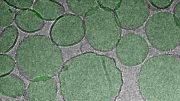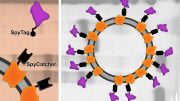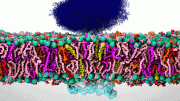
Some small molecules can lock SARS-CoV-2 spike proteins in a harmless closed configuration (left) instead of the infectious open configuration (right). Credit: Adapted from ACS Central Science 2023, DOI: 10.1021/acscentsci.2c01190
Using Small Molecules To Keep SARS-CoV-2 Closed for Business
The infamous spike proteins on the surface of SARS-CoV-2 help it bind to and enter human cells. Because of their important role in spreading infection, these spike proteins are one of the main targets for COVID-19 vaccines and treatments. But those remedies gradually lose effectiveness when certain segments of the spike proteins mutate. Now, researchers report in ACS Central Science that they have discovered small molecules that successfully target other segments that mutate less.
Spike proteins change shape when they attack a cell. In their “open” structure, they expose a section known as the receptor-binding domain (RBD) so it can attach to the ACE2 protein on human cells. In the “closed” structure, this RBD segment is tucked inside the spike protein and can’t bind to human cells. Antibodies contained in some COVID-19 therapies or stimulated by vaccines or infection target the RBD domain so it can’t bind to ACE2. However, some emerging variants of the coronavirus contain mutations in the RBD fragment. That means vaccines and antibody therapies designed to target that fragment could become less effective as the virus mutates.
To get around this problem, other, less mutation-prone parts of the spike protein could be targeted instead. One possibility is a pocket in the spike protein that has been dubbed the Achilles’ heel of the virus. When this cranny is occupied by free fatty acids (FFAs) or a few other compounds, the protein remains locked in its closed, harmless configuration. However, those compounds aren’t suitable treatments because they aren’t stable or they bind weakly. So, Jianhui Huang, Niu Huang, and colleagues decided to look for other potential treatments that lack these flaws.
Using computer modeling, the team screened a library of small molecules, seeking ones that could slip into this pocket and stick firmly to the spike protein, keeping it in the closed shape. The researchers then used surface plasmon resonance and other techniques to evaluate analogs of these molecules for improved binding and solubility. The resulting compounds, which can bind to spike proteins from the original coronavirus as well as the omicron BA.4 variant, could serve as a starting point for developing broad-spectrum treatments for COVID-19, the team says.
Reference: “In Silico Discovery of Small Molecule Modulators Targeting the Achilles' Heel of SARS-CoV-2 Spike Protein” by Qing Wang, Fanhao Meng, Yuting Xie, Wei Wang, Yumin Meng, Linjie Li, Tao Liu, Jianxun Qi, Xiaodan Ni, Sanduo Zheng, Jianhui Huang and Niu Huang, 8 February 2023, ACS Central Science.
DOI: 10.1021/acscentsci.2c01190
The authors acknowledge support from the Beijing Municipal Science & Technology Commission and Tsinghua University.









Be the first to comment on "Scientists Discover Small Molecules That Successfully Target COVID Spike Proteins"